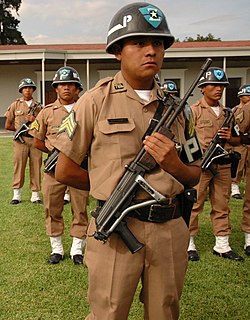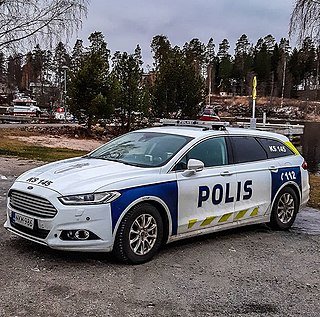A highway patrol is either a police unit created primarily for the purpose of overseeing and enforcing traffic safety compliance on roads and highways, or a detail within an existing local or regional police agency that is primarily concerned with such duties. They are also referred to in many countries as traffic police, although in other countries this term is more commonly used to refer to foot officers on point duty who control traffic at junctions.

Law enforcement in Australia is one of the three major components of the country's justice system, along with courts and corrections. Law enforcement officers are employed by all three levels of government – federal, state/territory, and local.
A military police vehicle is a vehicle used by the military police entities of a country's armed forces.

Merseyside Police is the territorial police force responsible for policing Merseyside in North West England. The service area is 647 square kilometres with a population of around 1.5 million. As of September 2017 the service has 3,484 police officers, 1,619 police staff, 253 police community support officers, 155 designated officers and 208 special constables. In terms of officer numbers, the force is the 8th largest of the 48 police forces of the United Kingdom. However, in terms of geographic area of responsibility, it is the 3rd smallest of the territorial police forces after the City of London Police and Cleveland Police. The force is led by Chief Constable Andy Cooke.

Police vehicles in the United States and Canada are produced by several manufacturers and are available in three broad vehicle types: Police Pursuit Vehicles (PPV), Special Service Vehicles (SSV), and Special Service Package (SSP).

The Brigade Speciale Beveiligingsopdrachten or BSB is a special operations unit of the Koninklijke Marechaussee, the Dutch gendarmerie corps. Although the BSB conducts special operations, it is not a part of the Netherlands Special Operations Command.

Law enforcement in Germany is constitutionally vested solely with the states, which is one of the main features of the German political system.
The Roads Policing Unit (RPU) is the motorway and trunk-road police unit of a British police force.

The Dienst Speciale Interventies, commonly abbreviated DSI, is the elite police tactical unit of the Dutch National Police Corps and was formally established on 1 July 2006. The DSI is tasked with neutralising terrorist incidents and other violent public order disruptions for which regular police units are inadequately equipped. In total, the DSI consists of about 550 active operators.

Baden-Württemberg Police is a state law-enforcement agency in Germany. It numbers approximately 25,000 police officers and 7,000 civilian employees.

Law enforcement in Belgium is conducted by an integrated police service structured on the federal and local levels, made up of the Federal Police and the Local Police. Both forces are autonomous and subordinate to different authorities, but linked in regard to reciprocal support, recruitment, manpower mobility and common training.

The Korps landelijke politiediensten was the national police force in the Netherlands from 1993 until 2013, responsible for specialist missions that benefited from a centralized approach.

Provosts are military police whose duties are policing solely within the armed forces of a country, as opposed to gendarmerie duties in the civilian population. However, many countries use their gendarmerie for provost duties.

Before 2001, there were several police forces in Belgium:
The police forces in the UK use a wide range of operational vehicles including compact cars, powerful estates and armored police carriers. The main uses are patrol, response, tactical pursuit and public order policing. Other vehicles used by British police include motorcycles, aircraft and boats.

The police of Denmark is the Danish National Police force, and the interior part of the Danish security forces in the Kingdom. The police are empowered to enforce the law and to effect public and social order, as well as being responsible for border control.

Police vehicles in Hong Kong are vehicles of the Hong Kong Police Force, vehicles differ considerably depending on the duties of the departments that the vehicle is assigned to. One of the most commonly seen police vehicles in Hong Kong is the Mercedes-Benz Sprinter police van, which is mostly used by district stations and the Emergency Unit, one of the roles expected of it is rapid response to 999 emergency calls with regards to road safety and public safety.
The Aruba Police Force is the law enforcement agency of the island of Aruba. The force operates under the authority of the Minister of Justice, Immigration and Integrity.

The Rendőrség is the national civil law enforcement agency of Hungary and is governed by the Interior Ministry. Until 2006, The Police operated under the authority of the Ministry of the Interior. From 2006 to 2010, the Ministry of Justice and Law Enforcement was the governing body of The Police, which absorbed the Border Guard on December 31, 2007.

The Police of Finland is a national government agency responsible for general police and law enforcement matters in Finland. The Police of Finland is subordinate to the Ministry of the Interior and consists of the National Police Board, two national police units and 11 local police departments.








































